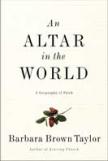Everyday Sacred
First, an acknowledgment: I am not new to the work of Barbara Brown Taylor. Years ago when I was in seminary, a friend of mine recommended her collection of sermons, Home By Another Way, as well as her thoughts on preaching called The Preaching Life, both of which I quickly devoured. Her sermons captivated my attention because she managed to take the Bible and bring it to life, drawing from her personal experiences or through everyday metaphors and images. Brown’s earlier writings are primarily collections of sermons, but more recently she has published a memoir entitled Leaving Church, a story of her longtime struggle leaving full-time parish ministry, as well as short essays for The Christian Century.
Though I have never had the opportunity to hear Brown preach, I can only imagine that her proclamation is as captivating as her writing. Her conversational writing style evokes that of Frederick Buechner, Nora Gallagher, Patricia Hampl and Kathleen Norris, who likewise write about holy and divine things in a nontechnical manner. Writers serve as prophets and translators, pointing out God’s work in the world to the rest of humanity, bearing witness to the Word through their written narratives. Both pro-phecy and writing are hard work, even painful at times, and Brown has earned her reputation by the sheer volume of publications, including her newest work, An Altar in the World.
With An Altar in the World, Brown leaves the confines of strictly “ecclesial or Church life” and leads her reader on an expedition of spirituality in a new and fresh way, one that is open to the world around us, free from the often cited rites, rubrics and rules of the Christian tradition: candles, hymns, prayers, prostrations, rosaries, holy water and saints. Rather, she takes up what Kathleen Norris has identified as the quotidian mysteries, or put in another way, spirituality or holiness of the everyday. Brown reminds us that even cleaning toilets can be a spiritual endeavor if done with the right attitude of grace, love and devotion for a clean house!
The main theme throughout these 12 chapters is that spirituality is not meant only for Sunday, but is for everyday living. One cannot confine God to the four walls of a church building. The prophet Ezekiel tells us as much, when God’s shekinah, his glory, left the Jerusalem Temple to dwell with his people in Babylon. Spirituality is meant to be lived, explored and incarnated in everyday living, whether at home with family, at work with colleagues or with one’s next door neighbor. Furthermore, what we may consider routine everyday chores can be seen as pathways to the divine. Brown draws from her vast experience in parish ministry as well as her recent teaching at Piedmont College to bring home her point, sharing stories about her class trips to various houses of worship in nearby Atlanta as well as her own life experience living in rural Habersham County, Ga.—through farming, raising chickens and such everyday tasks as hanging clothes on the clothesline.
The book’s title also reinforces her main theme, since Brown finds that God’s altar is not found just in the church sanctuary, near the pulpit and adjacent to the choir and organ, but in the middle of the created order—among the trees, rivers, streams and hills, as echoed throughout the Hebrew Bible (“Bless the Lord, streams and rivers….”). Enjoying the creation around us, even performing routine chores of everyday life can be sacramental. Reading Brown’s narrative reminded me of an essay that appeared a few years ago in The New York Times travel section, describing a rural village in Italy where every year in the summertime villagers closed off the streets to traffic in order to set out long tables in the streets. For several days the villagers, numbering a few hundred, ate dinner al fresco, under the Tuscan moonlight, with crusty bread, jugs of Chianti and of course plenty of pasta. This is as sacramental as it can get, people gathering together and sharing their joys, pains, hurts and struggles with one another while consuming a good meal, providing care and comfort; here echoes of the Eucharist abound.
We are still tempted, however, to keep God in a box, which we call church, opening it for a few minutes on occasion only to return it back to the shelf. Yet Brown rightly reminds us that this version of God might be too small; and I agree. An Altar in the World is a delight to the eyes, mind and heart, a book I will certainly return to again at a later time, if only to remind myself of the spirituality of everyday living.
This article also appeared in print, under the headline “Everyday Sacred,” in the February 9, 2009, issue.








